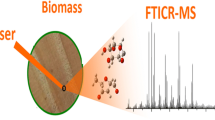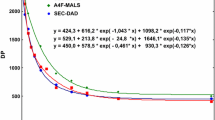Abstract
Cellulose paper degradation products forming in the “tideline” area at the wet-dry interface of pure cellulose paper were analyzed using gas chromatography-electron ionization-mass spectrometry (GC-EI-MS) and high-resolution electrospray ionization-mass spectrometry (ESI-MS, LTQ Orbitrap) techniques. Different extraction protocols were employed in order to solubilize the products of oxidative cellulose decomposition, i.e., a direct solvent extraction or a more laborious chromophore release and identification (CRI) technique aiming to reveal products responsible for paper discoloration in the tideline area. Several groups of low molecular weight compounds were identified, suggesting a complex pathway of cellulose decomposition in the tidelines formed at the cellulose-water-oxygen interface. Our findings, namely the appearance of a wide range of linear saturated carboxylic acids (from formic to nonanoic), support the oxidative autocatalytic mechanism of decomposition. In addition, the identification of several furanic compounds (which can be, in part, responsible for paper discoloration) plus anhydro carbohydrate derivatives sheds more light on the pathways of cellulose decomposition. Most notably, the mechanisms of tideline formation in the presence of molecular oxygen appear surprisingly similar to pathways of pyrolytic cellulose degradation. More complex chromophore compounds were not detected in this study, thereby revealing a difference between this short-term tideline experiment and longer-term cellulose aging.







Similar content being viewed by others
References
Bone WH. Evaporation of water from cellulose. J Soc Dyer Colour. 1934;50:307–9.
Bone WA, Turner HA. Some effects of the evaporation of water from cotton cellulose. J Soc Dyer Colour. 1950;66:315–27.
Bogaty H, Campbell KS, Appel WD. Some observations on the evaporation of water from cellulose. Text Res J. 1952;22:75–81.
Madaras GW, Turner HA. Further observations on the effects of evaporating water from cotton cellulose. J Soc Dyer Colour. 1953;69:371–7.
Schaffer R, Appel WD, Forziati FH. Reactions at wet-dry interfaces on fibrous materials. J Res Natl Bur Stand. 1955;54:103–6.
Fox MR. Wet and dry boundaries on cellulosic textiles and their influence on dyes and dyeing. I. J Soc Dyer Colour. 1965;81:7–11.
Dupont AL. Degradation of cellulose at the wet/dry interface. I. The effect of some conservation treatments on brown lines. Restaurator. 1996;17:1–21.
Dupont AL. Degradation of cellulose at the wet/dry interface. II. An approach to the identification of the oxidation compounds. Restaurator. 1996;17:145–64.
Area MC, Cheradame H. Paper aging and degradation: recent findings and research methods. BioResources. 2011;6:5307–37.
Souguir Z, Dupont AL. Formation of brown lines in paper: characterization of cellulose degradation at the wet-dry interface. Biomacromolecules. 2008;9:2546–52.
Jeong MJ, Dupont AL, René de la Rie E. Degradation of cellulose at the wet-dry interface. I. Study of the depolymerization. Cellulose. 2012;19:1135–47.
Jeong MJ, Dupont AL, René de la Rie E. Degradation of cellulose at the wet-dry interface. II. Study of oxidation reactions and effect of antioxidants. Carbohydr Polym. 2014;101:671–83.
Zervos S. Natural and accelerated ageing of cellulose and paper: a literature review. In: Lejeune A, Deprez T, editors. Cellulose: structure and properties, derivatives and industrial uses. New York: Nova Science Publishers Inc.; 2010. p. 155–203.
Albeck M, Ben-Bassat A, Epstein JA, Lewin M. The yellowing of cotton cellulose. Part I. A new method for the determination of yellowing. Text Res J. 1965;35:836–43.
Albeck M, Ben-Bassat A, Lewin M. The yellowing of cotton cellulose. Part II. The influence of functional groups and the nature of the yellowing. Text Res J. 1965;35:935–42.
Lewin M. The yellowing of cotton cellulose. Part III. On the mechanism of yellowing upon aging and alkaline extraction. Text Res J. 1965;35:979–86.
Łojewska J, Miśkowiec P, Łojewski T, Proniewicz LM. Cellulose oxidative and hydrolytic degradation: in situ FTIR approach. Polym Degrad Stab. 2005;88:512–20.
Łojewska J, Missori M, Lubańska A, Grimaldi P, Zięba K, Proniewicz LM, et al. Carbonyl groups development on degraded cellulose. Correlation between spectroscopic and chemical results. Appl Phys A. 2007;89:883–7.
Łojewski T, Zięba K, Knapik A, Bagniuk J, Lubańska A, Łojewska J. Evaluating paper degradation progress. Cross-linking between chromatographic, spectroscopic and chemical results. Appl Phys A. 2010;100:809–21.
Schedl A, Korntner P, Zweckmair T, Henniges U, Rosenau T, Potthast A. Detection of cellulose-derived chromophores by ambient ionization-MS. Anal Chem. 2016;88:1253–8.
Corsaro C, Mallamace D, Łojewska J, Mallamace F, Pietronero L, Missori M. Molecular degradation of ancient documents revealed by 1H HR-MAS NMR spectroscopy. Sci Rep. 2013;3:2896.
Mosca Conte A, Pulci O, Knapik A, Bagniuk J, Del Sole R, Lojewska J, et al. Role of cellulose oxidation in the yellowing of ancient paper. Phys Rev Lett. 2012;108:158301.
Violante C, Teodonio L, Mosca Conte A, Pulci O, Kupchak I, Missori M. An ab-initio approach to cultural heritage: the case of ancient paper degradation. Phys Status Solidi B. 2015;252:112–7.
Rosenau T, Potthast A, Milacher W, Hofinger A, Kosma P. Isolation and identification of residual chromophores in cellulosic materials. Polymer. 2004;45:6437–43.
Rosenau T, Potthast A, Krainz K, Yoneda Y, Dietz T, Shields ZPI, et al. Chromophores in cellulosics. VI. First isolation and identification of residual chromophores from aged cotton linters. Cellulose. 2011;18:1623–33.
Rosenau T, Potthast A, Krainz K, Hettegger H, Henniges U, Yoneda Y, et al. Chromophores in cellulosics. XI. Isolation and identification of residual chromophores from bacterial cellulose. Cellulose. 2014;21:2271–83.
Strlič M, Kralj Cigić I, Kolar J, de Bruin G, Pihlar B. Non-destructive evaluation of historical paper based on pH estimation from VOC emissions. Sensors. 2007;7:3136–45.
Lattuati-Derieux A, Bonnassies-Termes S, Lavédrine B. Characterisation of compounds emitted during natural and artificial ageing of a book. Use of headspace-solid-phase microextraction/gas chromatography/mass spectrometry. J Cult Herit. 2006;7:123–33.
Ramalho O, Dupont AL, Egasse C, Lattuati-Derieux A. Emission rates of volatile organic compounds from paper. e-Preserv Sci. 2009;6:53–9.
Dupont AL, Egasse C, Mori A, Vasseur F. Comprehensive characterisation of cellulose- and lignocellulose-degradation products in aged papers: capillary zone electrophoresis of low-molar mass organic acids, carbohydrates, and aromatic lignin derivatives. Carbohydr Polym. 2007;68:1–16.
Shahani CJ, Harrison G. Spontaneous formation of acids in the natural aging of paper. In: Daniels V, Donithorne A, Smith P, editors. Works of art on paper, books, documents and photographs. Techniques and conservation, Congress of the International Institute for Conservation. London: International Institute for Conservation; 2002. p. 189–92.
Deng T, Liu H. Direct conversion of cellulose into acetol on bimetallic Ni-SnOx/Al2O3 catalysts. J Mol Catal A Chem. 2014;388–389:66–73.
Ji N, Zhang T, Zheng MY, Wang AQ, Wang H, Wang XD, et al. Direct catalytic conversion of cellulose into ethylene glycol using nickel-promoted tungsten carbide catalysts. Angew Chem Int Ed. 2008;47:8510–3.
Lin YC, Cho J, Tompsett GA, Westmoreland PR, Huber GW. Kinetics and mechanism of cellulose pyrolysis. J Phys Chem C. 2009;113:20097–107.
Shenai VA, Sudan RK. Studies in chemically modified celluloses. IV. Lactones in chemically modified celluloses. J Appl Polym Sci. 1972;16:545–50.
Potthast A, Rosenau T, Kosma P. Analysis of oxidized functionalities in cellulose. Adv Polym Sci. 2006;205:1–48.
Tressl R, Kersten E. Formation of pyrroles, 2-pyrrolidones, and pyridones by heating of 4-aminobutyric acid and reducing sugars. J Agric Food Chem. 1993;41:2125–30.
Popoff T, Theander O. Formation of aromatic compounds from carbohydrates. Part I. Reaction of D-glucuronic acid, D-galacturonic acid, D-xylose, and L-arabinose in slightly acidic, aqueous solution. Carbohydr Res. 1972;22:135–49.
Lu Q, Yang XC, Dong CQ, Zhang ZF, Zhan XM, Zhu XF. Influence of pyrolysis temperature and time on the cellulose fast pyrolysis products: analytical Py-GC/MS study. J Anal Appl Pyrolysis. 2011;92:430–8.
Paine III JB, Pithawalla YB, Naworal JD. Carbohydrate pyrolysis mechanisms from isotopic labeling. Part 4. The pyrolysis of D-glucose: the formation of furans. J Anal Appl Pyrolysis. 2008;83:37–63.
Patwardhan PR, Satrio JA, Brown RC, Shanks BH. Product distribution from fast pyrolysis of glucose-based carbohydrates. J Anal Appl Pyrolysis. 2009;86:323–30.
Lu Q, Zhang ZF, Dong CQ, Zhu XF. Catalytic upgrading of biomass fast pyrolysis vapors with nano metal oxides: an analytical Py-GC/MS study. Energies. 2010;3:1805–20.
Pierson Y, Bobbink F, Yan N. Alcohol mediated liquefaction of lignocellulosic materials: a mini review. Chem Eng Process Technol. 2013;1:1014.
Alonso DM, Gallo JMR, Mellmer MA, Wettstein SG, Dumesic JA. Direct conversion of cellulose to levulinic acid and gamma-valerolactone using solid acid catalysts. Catal Sci Technol. 2013;3:927–31.
Halpern Y, Riffer R, Broido A. Levoglucosenone (1,6-anhydro-3,4-dideoxy-Δ3-β-D-pyranosen-2-one). A major product of the acid-catalyzed pyrolysis of cellulose and related carbohydrates. J Org Chem. 1973;38:204–9.
Acknowledgments
SS thanks the Chateaubriand Fellowship Program for the financial support for this research. SS also thanks the Office of Scientific and Academic Cooperation at the French Embassy in Israel for the support. We thank Agilent Technologies (Les Ulis, France) for providing the GC-MS equipment necessary to complete the project.
Author information
Authors and Affiliations
Corresponding authors
Ethics declarations
Conflict of interest
The authors declare that they have no conflict of interest.
Electronic supplementary material
Below is the link to the electronic supplementary material.
ESM 1
(PDF 231 kb)
Rights and permissions
About this article
Cite this article
Sladkevich, S., Dupont, AL., Sablier, M. et al. Understanding paper degradation: identification of products of cellulosic paper decomposition at the wet-dry “tideline” interface using GC-MS. Anal Bioanal Chem 408, 8133–8147 (2016). https://doi.org/10.1007/s00216-016-9916-y
Received:
Revised:
Accepted:
Published:
Issue Date:
DOI: https://doi.org/10.1007/s00216-016-9916-y




